Comprehensive Report: Business Operations, HR, Accounting, Leadership
VerifiedAdded on 2020/10/22
|11
|2412
|160
Report
AI Summary
This report provides a comprehensive analysis of business operations, encompassing various key aspects. It begins by highlighting the importance of accounting for business success, emphasizing its role in financial management and decision-making. The report then delves into the functions of the HR department, including training and development, recruitment, promotion, health and safety, and staffing. It also explores employment legislation, detailing its benefits to employees and its impact on businesses. The report further examines profit and loss accountability, team development stages, and the roles within a team, including the responsibilities of a Business Development Manager and team members. It also explains different motivation theories and leadership styles, such as autocratic, democratic, transformational, cross-cultural, and situational leadership. Finally, the report concludes by summarizing the key findings and insights gained throughout the analysis.
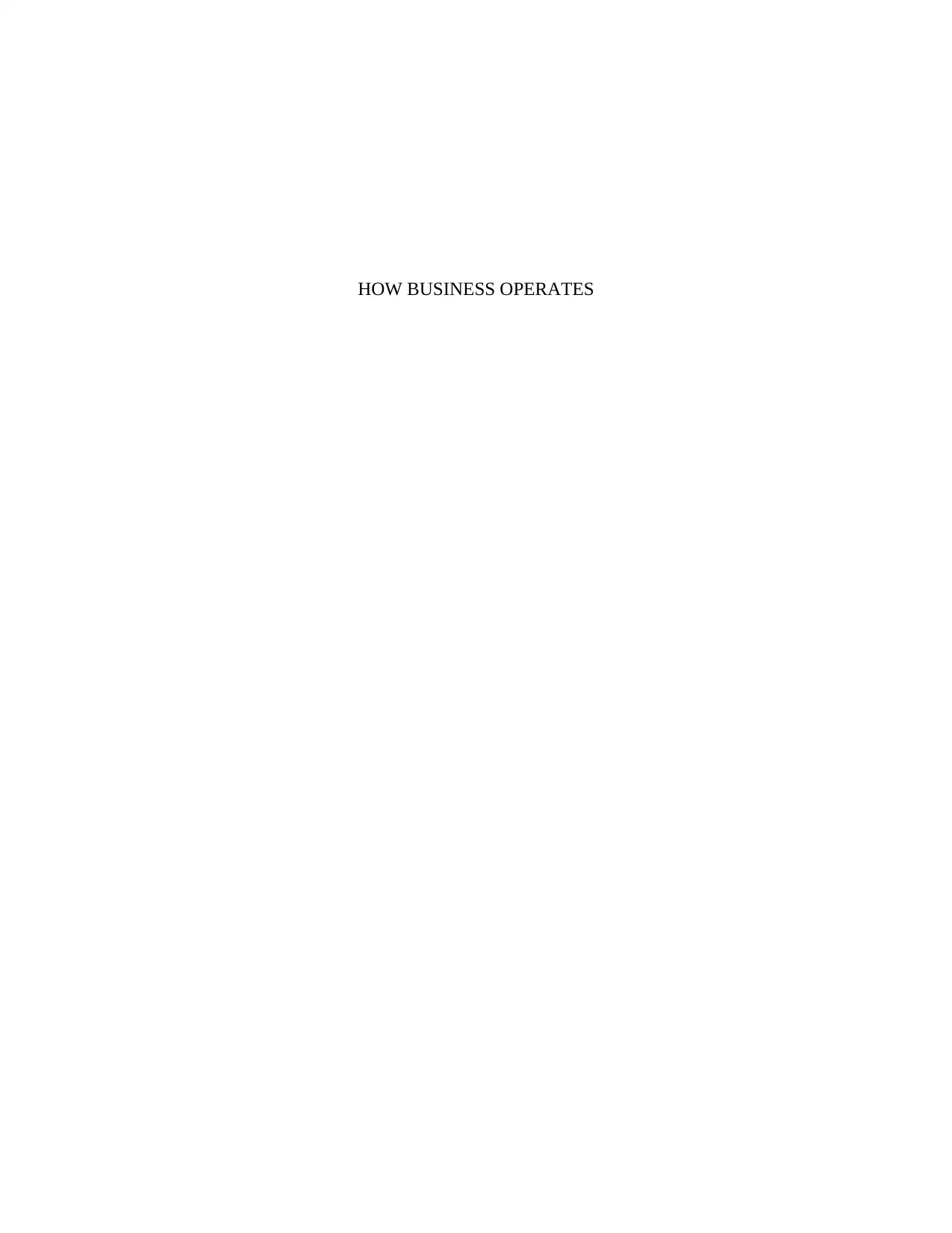
HOW BUSINESS OPERATES
Paraphrase This Document
Need a fresh take? Get an instant paraphrase of this document with our AI Paraphraser
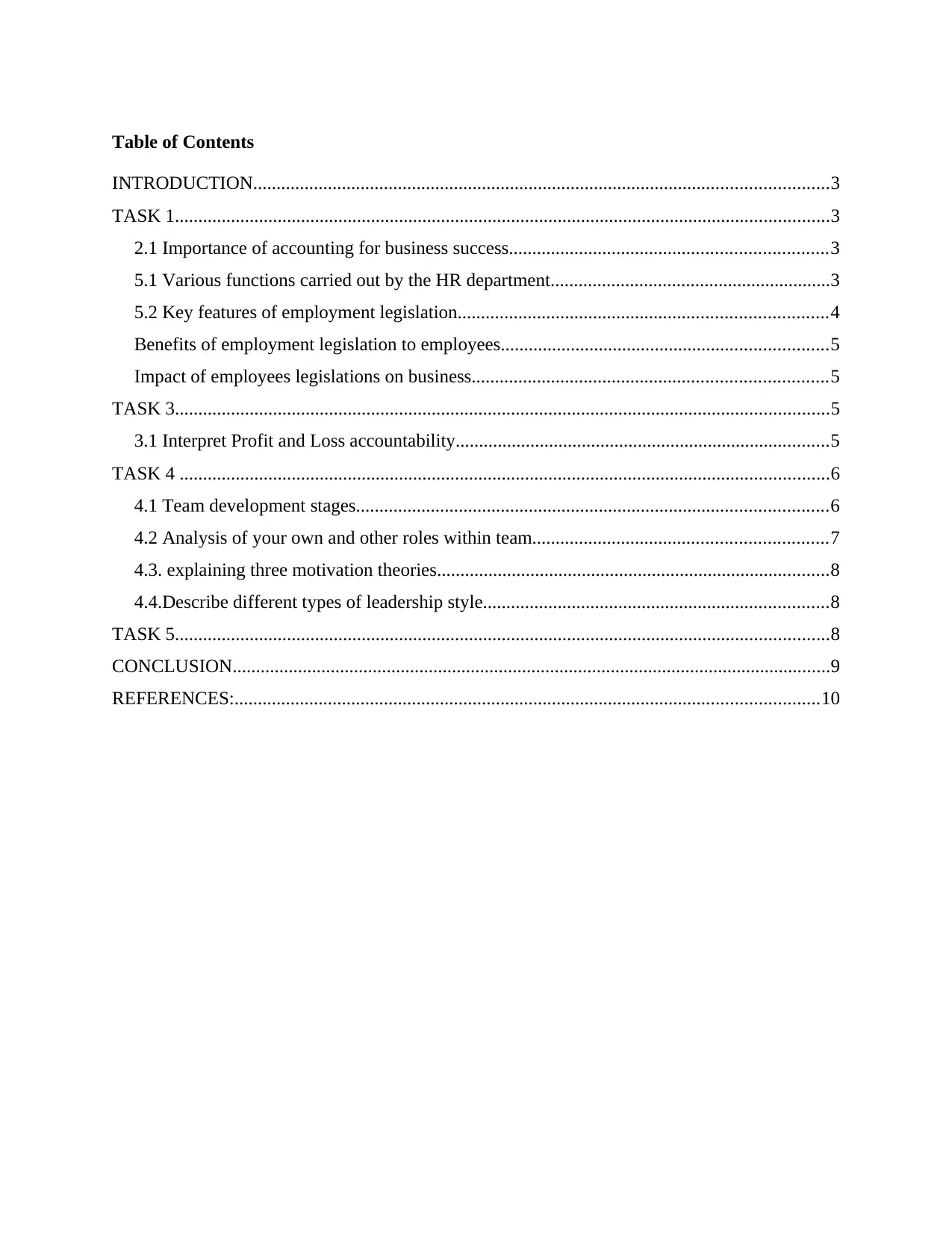
Table of Contents
INTRODUCTION...........................................................................................................................3
TASK 1............................................................................................................................................3
2.1 Importance of accounting for business success....................................................................3
5.1 Various functions carried out by the HR department............................................................3
5.2 Key features of employment legislation...............................................................................4
Benefits of employment legislation to employees......................................................................5
Impact of employees legislations on business............................................................................5
TASK 3............................................................................................................................................5
3.1 Interpret Profit and Loss accountability................................................................................5
TASK 4 ...........................................................................................................................................6
4.1 Team development stages.....................................................................................................6
4.2 Analysis of your own and other roles within team...............................................................7
4.3. explaining three motivation theories....................................................................................8
4.4.Describe different types of leadership style..........................................................................8
TASK 5............................................................................................................................................8
CONCLUSION................................................................................................................................9
REFERENCES:.............................................................................................................................10
INTRODUCTION...........................................................................................................................3
TASK 1............................................................................................................................................3
2.1 Importance of accounting for business success....................................................................3
5.1 Various functions carried out by the HR department............................................................3
5.2 Key features of employment legislation...............................................................................4
Benefits of employment legislation to employees......................................................................5
Impact of employees legislations on business............................................................................5
TASK 3............................................................................................................................................5
3.1 Interpret Profit and Loss accountability................................................................................5
TASK 4 ...........................................................................................................................................6
4.1 Team development stages.....................................................................................................6
4.2 Analysis of your own and other roles within team...............................................................7
4.3. explaining three motivation theories....................................................................................8
4.4.Describe different types of leadership style..........................................................................8
TASK 5............................................................................................................................................8
CONCLUSION................................................................................................................................9
REFERENCES:.............................................................................................................................10
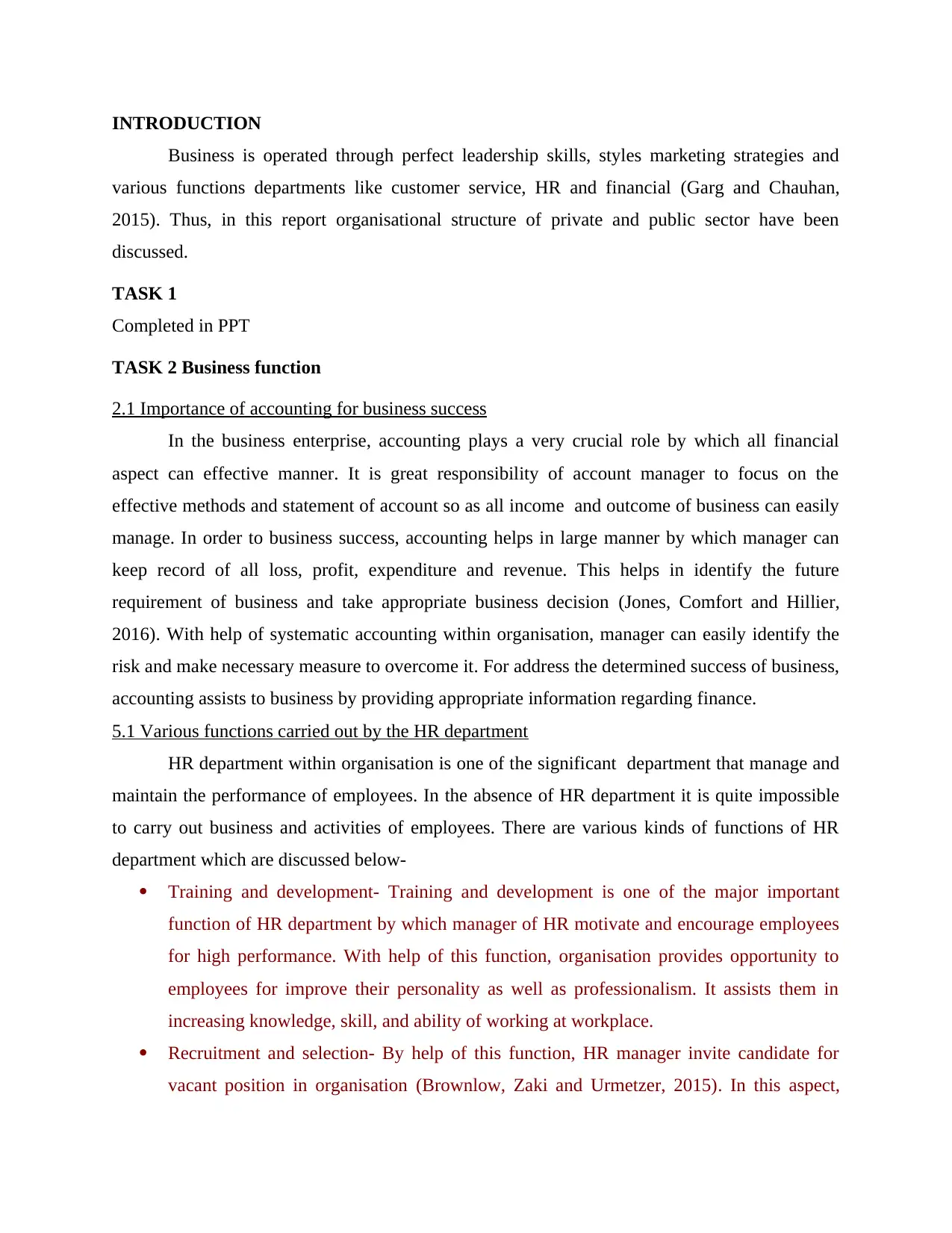
INTRODUCTION
Business is operated through perfect leadership skills, styles marketing strategies and
various functions departments like customer service, HR and financial (Garg and Chauhan,
2015). Thus, in this report organisational structure of private and public sector have been
discussed.
TASK 1
Completed in PPT
TASK 2 Business function
2.1 Importance of accounting for business success
In the business enterprise, accounting plays a very crucial role by which all financial
aspect can effective manner. It is great responsibility of account manager to focus on the
effective methods and statement of account so as all income and outcome of business can easily
manage. In order to business success, accounting helps in large manner by which manager can
keep record of all loss, profit, expenditure and revenue. This helps in identify the future
requirement of business and take appropriate business decision (Jones, Comfort and Hillier,
2016). With help of systematic accounting within organisation, manager can easily identify the
risk and make necessary measure to overcome it. For address the determined success of business,
accounting assists to business by providing appropriate information regarding finance.
5.1 Various functions carried out by the HR department
HR department within organisation is one of the significant department that manage and
maintain the performance of employees. In the absence of HR department it is quite impossible
to carry out business and activities of employees. There are various kinds of functions of HR
department which are discussed below-
Training and development- Training and development is one of the major important
function of HR department by which manager of HR motivate and encourage employees
for high performance. With help of this function, organisation provides opportunity to
employees for improve their personality as well as professionalism. It assists them in
increasing knowledge, skill, and ability of working at workplace.
Recruitment and selection- By help of this function, HR manager invite candidate for
vacant position in organisation (Brownlow, Zaki and Urmetzer, 2015). In this aspect,
Business is operated through perfect leadership skills, styles marketing strategies and
various functions departments like customer service, HR and financial (Garg and Chauhan,
2015). Thus, in this report organisational structure of private and public sector have been
discussed.
TASK 1
Completed in PPT
TASK 2 Business function
2.1 Importance of accounting for business success
In the business enterprise, accounting plays a very crucial role by which all financial
aspect can effective manner. It is great responsibility of account manager to focus on the
effective methods and statement of account so as all income and outcome of business can easily
manage. In order to business success, accounting helps in large manner by which manager can
keep record of all loss, profit, expenditure and revenue. This helps in identify the future
requirement of business and take appropriate business decision (Jones, Comfort and Hillier,
2016). With help of systematic accounting within organisation, manager can easily identify the
risk and make necessary measure to overcome it. For address the determined success of business,
accounting assists to business by providing appropriate information regarding finance.
5.1 Various functions carried out by the HR department
HR department within organisation is one of the significant department that manage and
maintain the performance of employees. In the absence of HR department it is quite impossible
to carry out business and activities of employees. There are various kinds of functions of HR
department which are discussed below-
Training and development- Training and development is one of the major important
function of HR department by which manager of HR motivate and encourage employees
for high performance. With help of this function, organisation provides opportunity to
employees for improve their personality as well as professionalism. It assists them in
increasing knowledge, skill, and ability of working at workplace.
Recruitment and selection- By help of this function, HR manager invite candidate for
vacant position in organisation (Brownlow, Zaki and Urmetzer, 2015). In this aspect,
⊘ This is a preview!⊘
Do you want full access?
Subscribe today to unlock all pages.

Trusted by 1+ million students worldwide
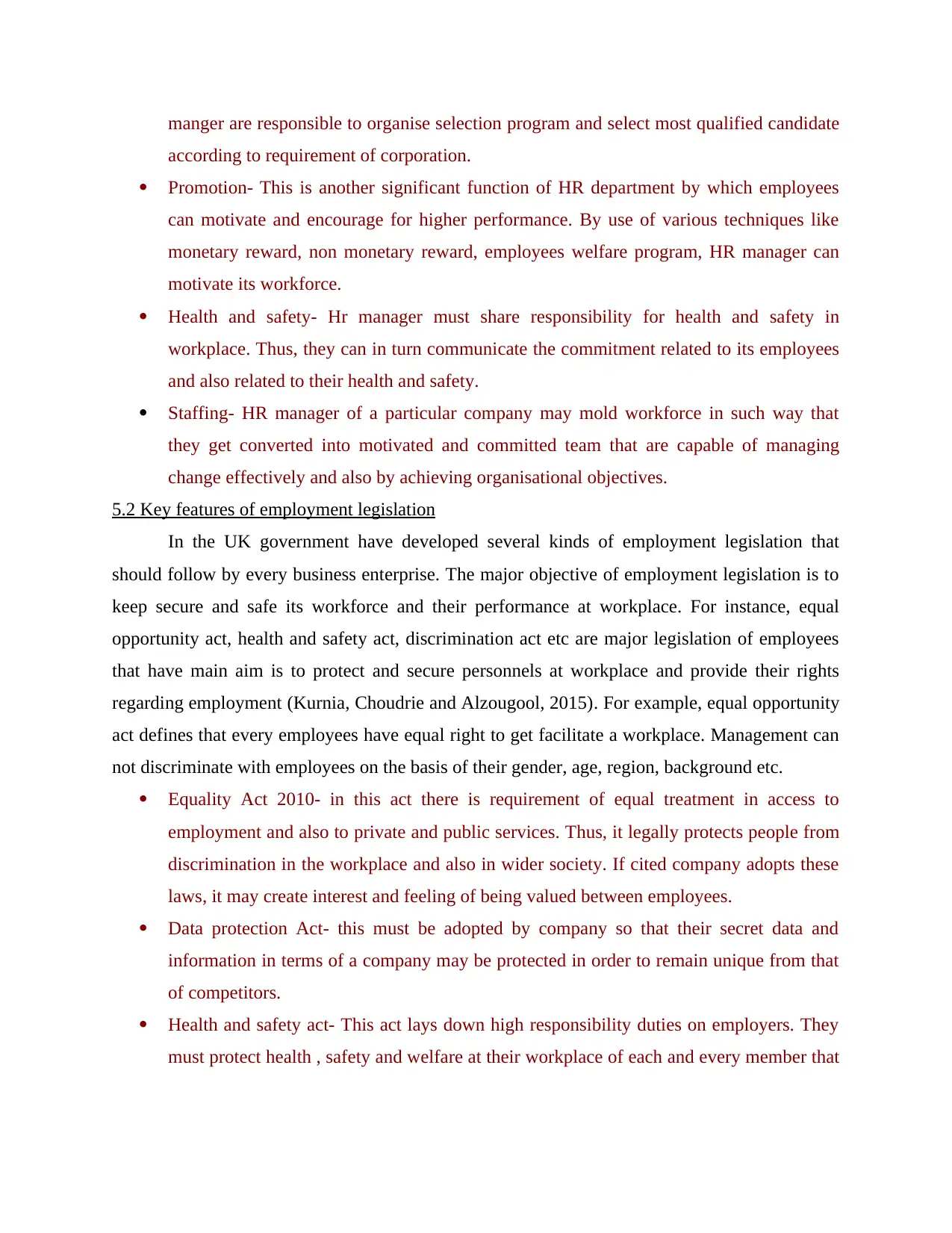
manger are responsible to organise selection program and select most qualified candidate
according to requirement of corporation.
Promotion- This is another significant function of HR department by which employees
can motivate and encourage for higher performance. By use of various techniques like
monetary reward, non monetary reward, employees welfare program, HR manager can
motivate its workforce.
Health and safety- Hr manager must share responsibility for health and safety in
workplace. Thus, they can in turn communicate the commitment related to its employees
and also related to their health and safety.
Staffing- HR manager of a particular company may mold workforce in such way that
they get converted into motivated and committed team that are capable of managing
change effectively and also by achieving organisational objectives.
5.2 Key features of employment legislation
In the UK government have developed several kinds of employment legislation that
should follow by every business enterprise. The major objective of employment legislation is to
keep secure and safe its workforce and their performance at workplace. For instance, equal
opportunity act, health and safety act, discrimination act etc are major legislation of employees
that have main aim is to protect and secure personnels at workplace and provide their rights
regarding employment (Kurnia, Choudrie and Alzougool, 2015). For example, equal opportunity
act defines that every employees have equal right to get facilitate a workplace. Management can
not discriminate with employees on the basis of their gender, age, region, background etc.
Equality Act 2010- in this act there is requirement of equal treatment in access to
employment and also to private and public services. Thus, it legally protects people from
discrimination in the workplace and also in wider society. If cited company adopts these
laws, it may create interest and feeling of being valued between employees.
Data protection Act- this must be adopted by company so that their secret data and
information in terms of a company may be protected in order to remain unique from that
of competitors.
Health and safety act- This act lays down high responsibility duties on employers. They
must protect health , safety and welfare at their workplace of each and every member that
according to requirement of corporation.
Promotion- This is another significant function of HR department by which employees
can motivate and encourage for higher performance. By use of various techniques like
monetary reward, non monetary reward, employees welfare program, HR manager can
motivate its workforce.
Health and safety- Hr manager must share responsibility for health and safety in
workplace. Thus, they can in turn communicate the commitment related to its employees
and also related to their health and safety.
Staffing- HR manager of a particular company may mold workforce in such way that
they get converted into motivated and committed team that are capable of managing
change effectively and also by achieving organisational objectives.
5.2 Key features of employment legislation
In the UK government have developed several kinds of employment legislation that
should follow by every business enterprise. The major objective of employment legislation is to
keep secure and safe its workforce and their performance at workplace. For instance, equal
opportunity act, health and safety act, discrimination act etc are major legislation of employees
that have main aim is to protect and secure personnels at workplace and provide their rights
regarding employment (Kurnia, Choudrie and Alzougool, 2015). For example, equal opportunity
act defines that every employees have equal right to get facilitate a workplace. Management can
not discriminate with employees on the basis of their gender, age, region, background etc.
Equality Act 2010- in this act there is requirement of equal treatment in access to
employment and also to private and public services. Thus, it legally protects people from
discrimination in the workplace and also in wider society. If cited company adopts these
laws, it may create interest and feeling of being valued between employees.
Data protection Act- this must be adopted by company so that their secret data and
information in terms of a company may be protected in order to remain unique from that
of competitors.
Health and safety act- This act lays down high responsibility duties on employers. They
must protect health , safety and welfare at their workplace of each and every member that
Paraphrase This Document
Need a fresh take? Get an instant paraphrase of this document with our AI Paraphraser
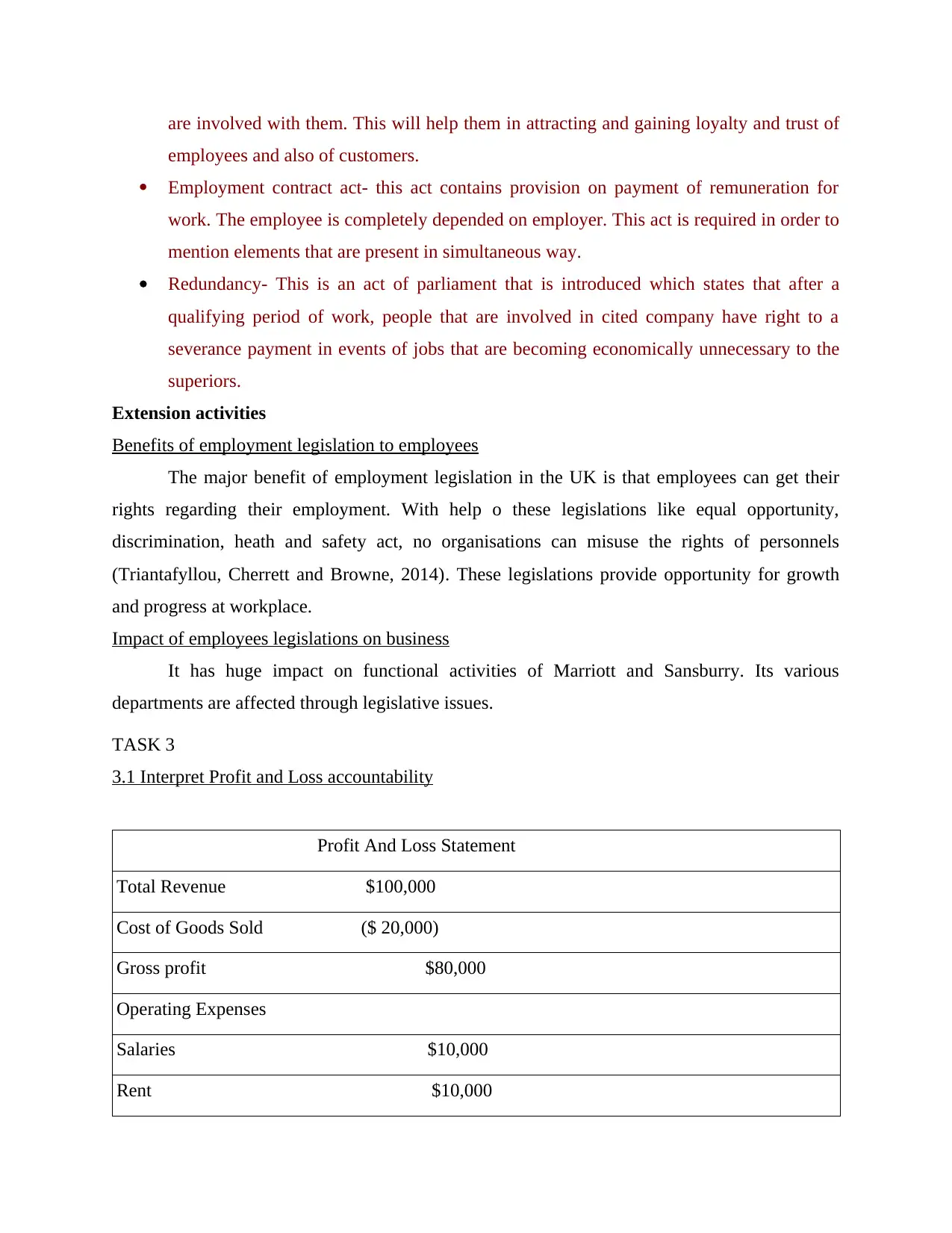
are involved with them. This will help them in attracting and gaining loyalty and trust of
employees and also of customers.
Employment contract act- this act contains provision on payment of remuneration for
work. The employee is completely depended on employer. This act is required in order to
mention elements that are present in simultaneous way.
Redundancy- This is an act of parliament that is introduced which states that after a
qualifying period of work, people that are involved in cited company have right to a
severance payment in events of jobs that are becoming economically unnecessary to the
superiors.
Extension activities
Benefits of employment legislation to employees
The major benefit of employment legislation in the UK is that employees can get their
rights regarding their employment. With help o these legislations like equal opportunity,
discrimination, heath and safety act, no organisations can misuse the rights of personnels
(Triantafyllou, Cherrett and Browne, 2014). These legislations provide opportunity for growth
and progress at workplace.
Impact of employees legislations on business
It has huge impact on functional activities of Marriott and Sansburry. Its various
departments are affected through legislative issues.
TASK 3
3.1 Interpret Profit and Loss accountability
Profit And Loss Statement
Total Revenue $100,000
Cost of Goods Sold ($ 20,000)
Gross profit $80,000
Operating Expenses
Salaries $10,000
Rent $10,000
employees and also of customers.
Employment contract act- this act contains provision on payment of remuneration for
work. The employee is completely depended on employer. This act is required in order to
mention elements that are present in simultaneous way.
Redundancy- This is an act of parliament that is introduced which states that after a
qualifying period of work, people that are involved in cited company have right to a
severance payment in events of jobs that are becoming economically unnecessary to the
superiors.
Extension activities
Benefits of employment legislation to employees
The major benefit of employment legislation in the UK is that employees can get their
rights regarding their employment. With help o these legislations like equal opportunity,
discrimination, heath and safety act, no organisations can misuse the rights of personnels
(Triantafyllou, Cherrett and Browne, 2014). These legislations provide opportunity for growth
and progress at workplace.
Impact of employees legislations on business
It has huge impact on functional activities of Marriott and Sansburry. Its various
departments are affected through legislative issues.
TASK 3
3.1 Interpret Profit and Loss accountability
Profit And Loss Statement
Total Revenue $100,000
Cost of Goods Sold ($ 20,000)
Gross profit $80,000
Operating Expenses
Salaries $10,000
Rent $10,000
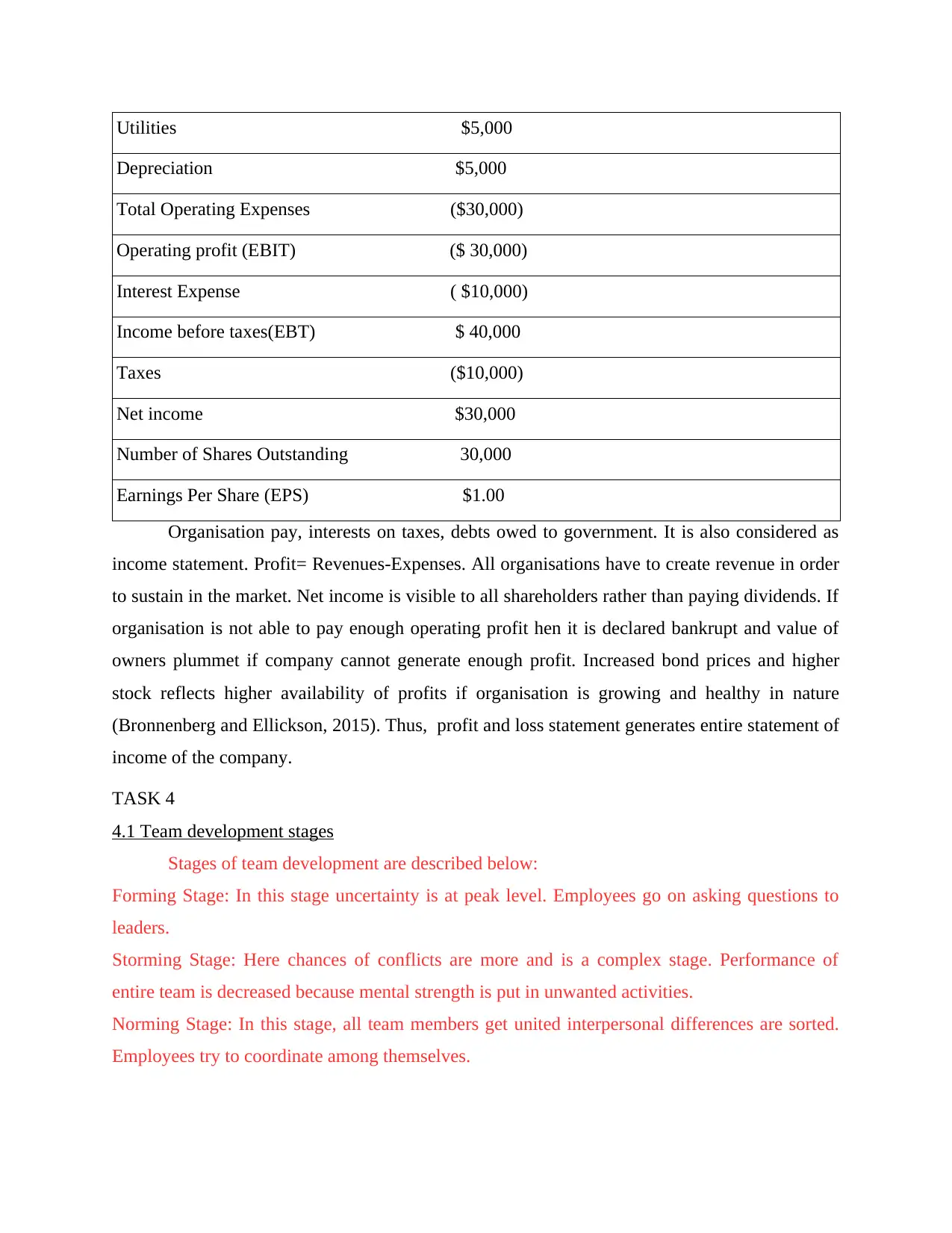
Utilities $5,000
Depreciation $5,000
Total Operating Expenses ($30,000)
Operating profit (EBIT) ($ 30,000)
Interest Expense ( $10,000)
Income before taxes(EBT) $ 40,000
Taxes ($10,000)
Net income $30,000
Number of Shares Outstanding 30,000
Earnings Per Share (EPS) $1.00
Organisation pay, interests on taxes, debts owed to government. It is also considered as
income statement. Profit= Revenues-Expenses. All organisations have to create revenue in order
to sustain in the market. Net income is visible to all shareholders rather than paying dividends. If
organisation is not able to pay enough operating profit hen it is declared bankrupt and value of
owners plummet if company cannot generate enough profit. Increased bond prices and higher
stock reflects higher availability of profits if organisation is growing and healthy in nature
(Bronnenberg and Ellickson, 2015). Thus, profit and loss statement generates entire statement of
income of the company.
TASK 4
4.1 Team development stages
Stages of team development are described below:
Forming Stage: In this stage uncertainty is at peak level. Employees go on asking questions to
leaders.
Storming Stage: Here chances of conflicts are more and is a complex stage. Performance of
entire team is decreased because mental strength is put in unwanted activities.
Norming Stage: In this stage, all team members get united interpersonal differences are sorted.
Employees try to coordinate among themselves.
Depreciation $5,000
Total Operating Expenses ($30,000)
Operating profit (EBIT) ($ 30,000)
Interest Expense ( $10,000)
Income before taxes(EBT) $ 40,000
Taxes ($10,000)
Net income $30,000
Number of Shares Outstanding 30,000
Earnings Per Share (EPS) $1.00
Organisation pay, interests on taxes, debts owed to government. It is also considered as
income statement. Profit= Revenues-Expenses. All organisations have to create revenue in order
to sustain in the market. Net income is visible to all shareholders rather than paying dividends. If
organisation is not able to pay enough operating profit hen it is declared bankrupt and value of
owners plummet if company cannot generate enough profit. Increased bond prices and higher
stock reflects higher availability of profits if organisation is growing and healthy in nature
(Bronnenberg and Ellickson, 2015). Thus, profit and loss statement generates entire statement of
income of the company.
TASK 4
4.1 Team development stages
Stages of team development are described below:
Forming Stage: In this stage uncertainty is at peak level. Employees go on asking questions to
leaders.
Storming Stage: Here chances of conflicts are more and is a complex stage. Performance of
entire team is decreased because mental strength is put in unwanted activities.
Norming Stage: In this stage, all team members get united interpersonal differences are sorted.
Employees try to coordinate among themselves.
⊘ This is a preview!⊘
Do you want full access?
Subscribe today to unlock all pages.

Trusted by 1+ million students worldwide
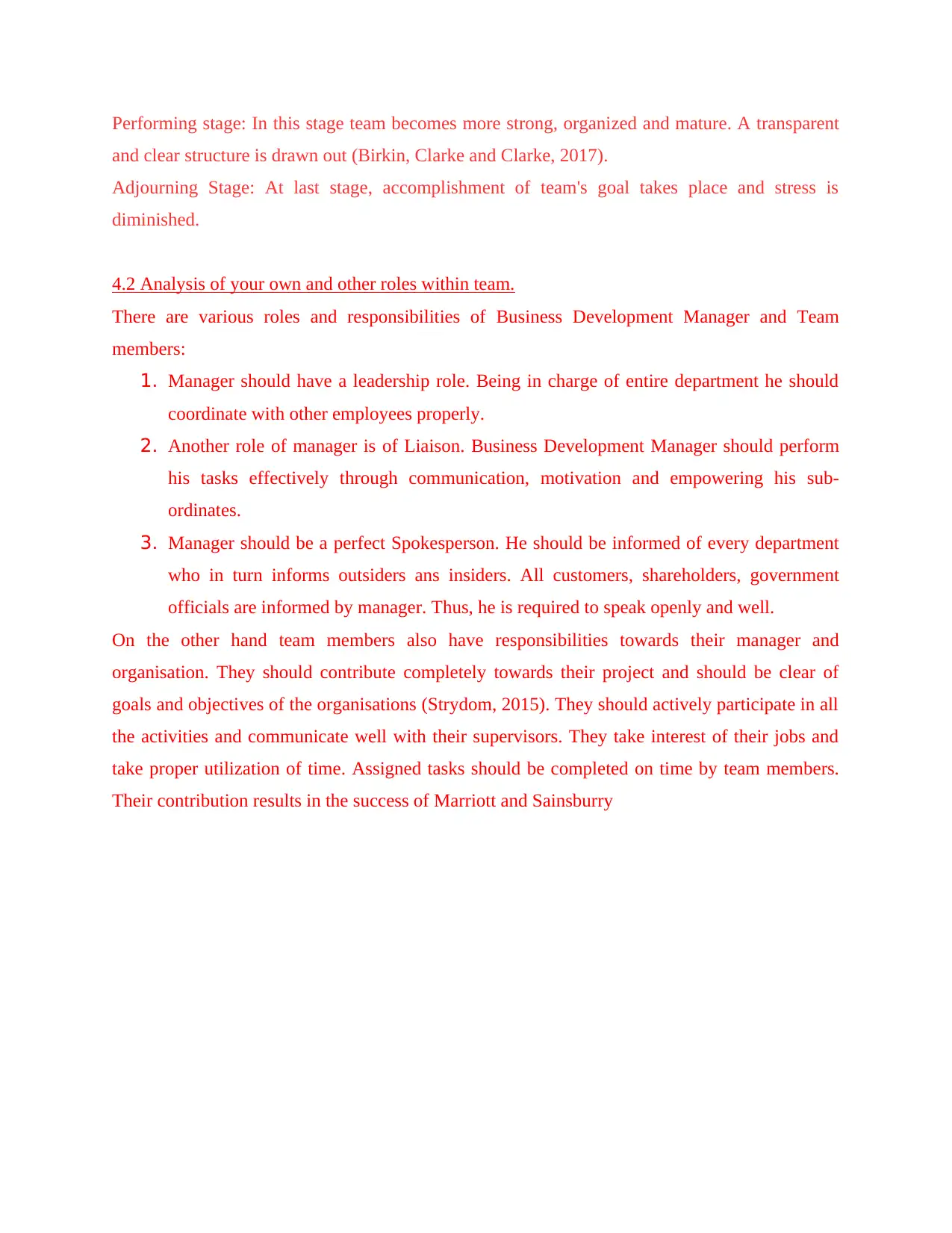
Performing stage: In this stage team becomes more strong, organized and mature. A transparent
and clear structure is drawn out (Birkin, Clarke and Clarke, 2017).
Adjourning Stage: At last stage, accomplishment of team's goal takes place and stress is
diminished.
4.2 Analysis of your own and other roles within team.
There are various roles and responsibilities of Business Development Manager and Team
members:
1. Manager should have a leadership role. Being in charge of entire department he should
coordinate with other employees properly.
2. Another role of manager is of Liaison. Business Development Manager should perform
his tasks effectively through communication, motivation and empowering his sub-
ordinates.
3. Manager should be a perfect Spokesperson. He should be informed of every department
who in turn informs outsiders ans insiders. All customers, shareholders, government
officials are informed by manager. Thus, he is required to speak openly and well.
On the other hand team members also have responsibilities towards their manager and
organisation. They should contribute completely towards their project and should be clear of
goals and objectives of the organisations (Strydom, 2015). They should actively participate in all
the activities and communicate well with their supervisors. They take interest of their jobs and
take proper utilization of time. Assigned tasks should be completed on time by team members.
Their contribution results in the success of Marriott and Sainsburry
and clear structure is drawn out (Birkin, Clarke and Clarke, 2017).
Adjourning Stage: At last stage, accomplishment of team's goal takes place and stress is
diminished.
4.2 Analysis of your own and other roles within team.
There are various roles and responsibilities of Business Development Manager and Team
members:
1. Manager should have a leadership role. Being in charge of entire department he should
coordinate with other employees properly.
2. Another role of manager is of Liaison. Business Development Manager should perform
his tasks effectively through communication, motivation and empowering his sub-
ordinates.
3. Manager should be a perfect Spokesperson. He should be informed of every department
who in turn informs outsiders ans insiders. All customers, shareholders, government
officials are informed by manager. Thus, he is required to speak openly and well.
On the other hand team members also have responsibilities towards their manager and
organisation. They should contribute completely towards their project and should be clear of
goals and objectives of the organisations (Strydom, 2015). They should actively participate in all
the activities and communicate well with their supervisors. They take interest of their jobs and
take proper utilization of time. Assigned tasks should be completed on time by team members.
Their contribution results in the success of Marriott and Sainsburry
Paraphrase This Document
Need a fresh take? Get an instant paraphrase of this document with our AI Paraphraser
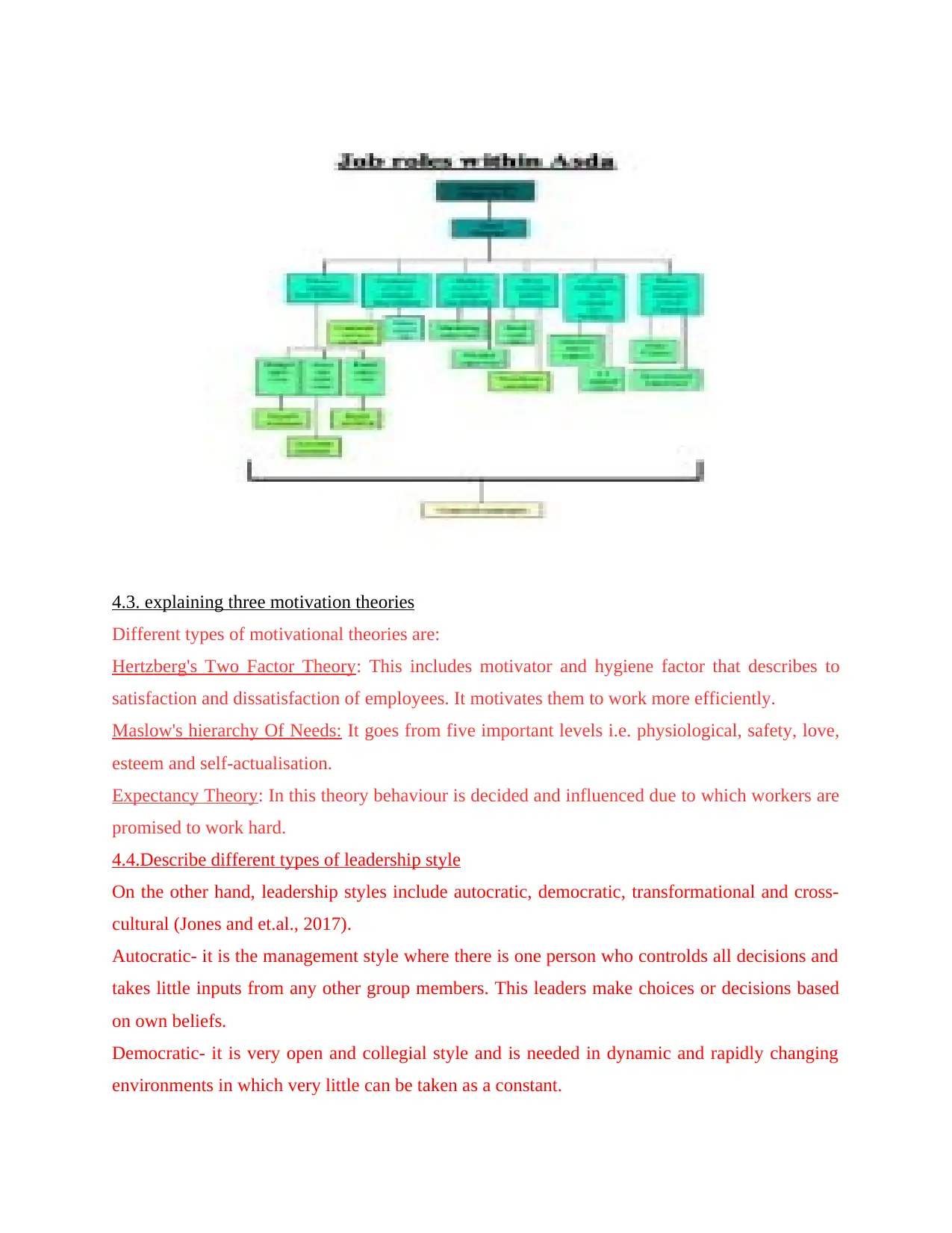
4.3. explaining three motivation theories
Different types of motivational theories are:
Hertzberg's Two Factor Theory: This includes motivator and hygiene factor that describes to
satisfaction and dissatisfaction of employees. It motivates them to work more efficiently.
Maslow's hierarchy Of Needs: It goes from five important levels i.e. physiological, safety, love,
esteem and self-actualisation.
Expectancy Theory: In this theory behaviour is decided and influenced due to which workers are
promised to work hard.
4.4.Describe different types of leadership style
On the other hand, leadership styles include autocratic, democratic, transformational and cross-
cultural (Jones and et.al., 2017).
Autocratic- it is the management style where there is one person who controlds all decisions and
takes little inputs from any other group members. This leaders make choices or decisions based
on own beliefs.
Democratic- it is very open and collegial style and is needed in dynamic and rapidly changing
environments in which very little can be taken as a constant.
Different types of motivational theories are:
Hertzberg's Two Factor Theory: This includes motivator and hygiene factor that describes to
satisfaction and dissatisfaction of employees. It motivates them to work more efficiently.
Maslow's hierarchy Of Needs: It goes from five important levels i.e. physiological, safety, love,
esteem and self-actualisation.
Expectancy Theory: In this theory behaviour is decided and influenced due to which workers are
promised to work hard.
4.4.Describe different types of leadership style
On the other hand, leadership styles include autocratic, democratic, transformational and cross-
cultural (Jones and et.al., 2017).
Autocratic- it is the management style where there is one person who controlds all decisions and
takes little inputs from any other group members. This leaders make choices or decisions based
on own beliefs.
Democratic- it is very open and collegial style and is needed in dynamic and rapidly changing
environments in which very little can be taken as a constant.
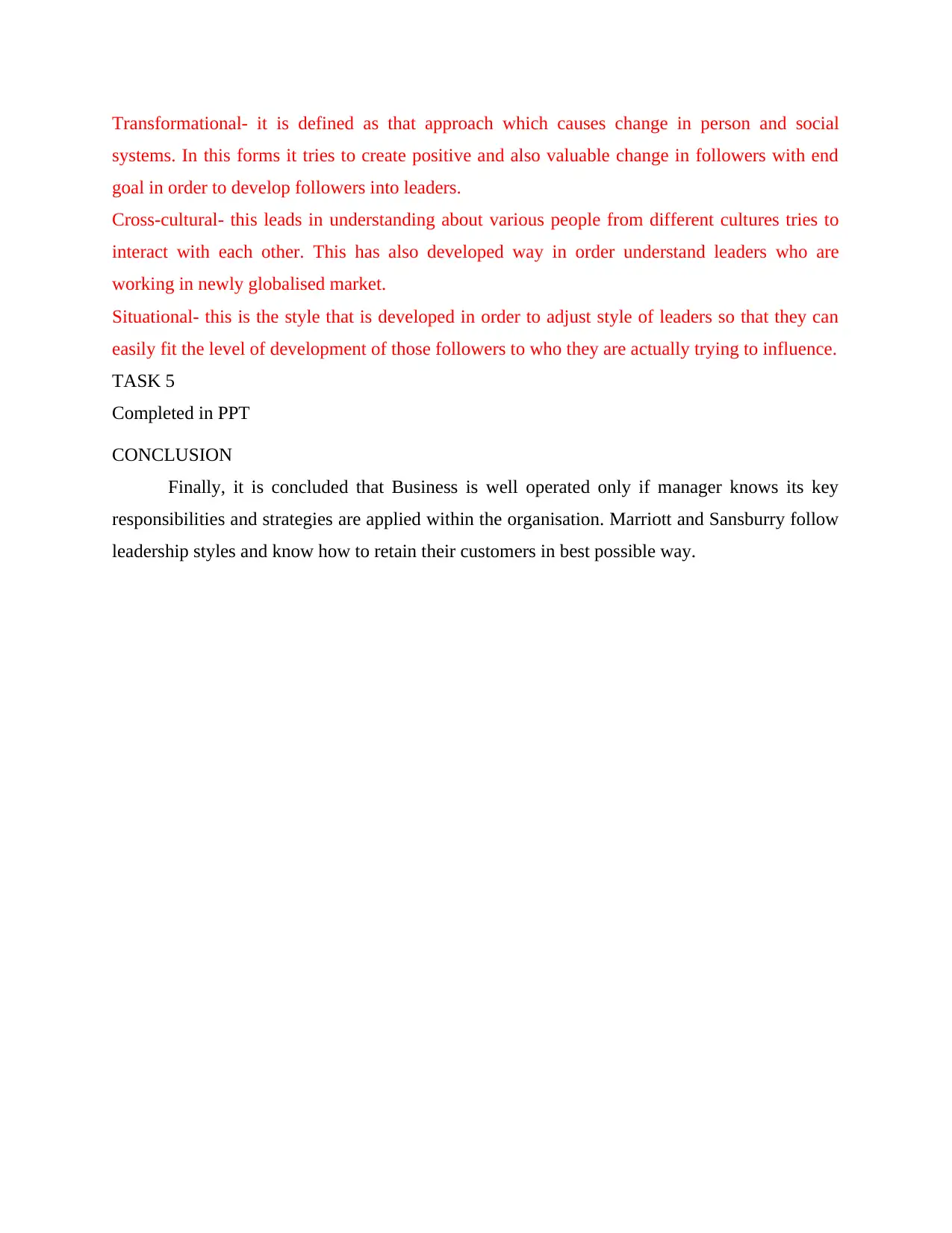
Transformational- it is defined as that approach which causes change in person and social
systems. In this forms it tries to create positive and also valuable change in followers with end
goal in order to develop followers into leaders.
Cross-cultural- this leads in understanding about various people from different cultures tries to
interact with each other. This has also developed way in order understand leaders who are
working in newly globalised market.
Situational- this is the style that is developed in order to adjust style of leaders so that they can
easily fit the level of development of those followers to who they are actually trying to influence.
TASK 5
Completed in PPT
CONCLUSION
Finally, it is concluded that Business is well operated only if manager knows its key
responsibilities and strategies are applied within the organisation. Marriott and Sansburry follow
leadership styles and know how to retain their customers in best possible way.
systems. In this forms it tries to create positive and also valuable change in followers with end
goal in order to develop followers into leaders.
Cross-cultural- this leads in understanding about various people from different cultures tries to
interact with each other. This has also developed way in order understand leaders who are
working in newly globalised market.
Situational- this is the style that is developed in order to adjust style of leaders so that they can
easily fit the level of development of those followers to who they are actually trying to influence.
TASK 5
Completed in PPT
CONCLUSION
Finally, it is concluded that Business is well operated only if manager knows its key
responsibilities and strategies are applied within the organisation. Marriott and Sansburry follow
leadership styles and know how to retain their customers in best possible way.
⊘ This is a preview!⊘
Do you want full access?
Subscribe today to unlock all pages.

Trusted by 1+ million students worldwide
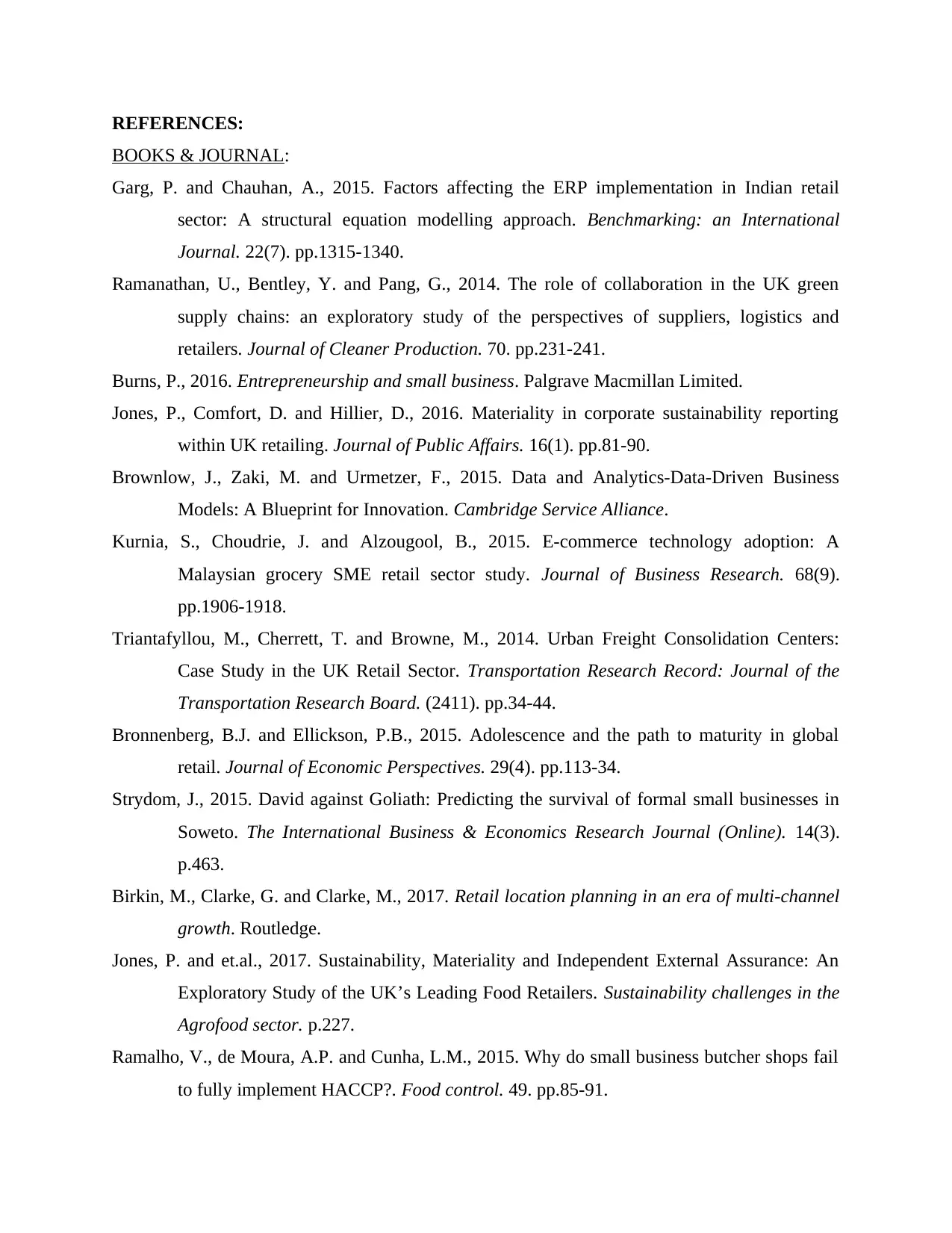
REFERENCES:
BOOKS & JOURNAL:
Garg, P. and Chauhan, A., 2015. Factors affecting the ERP implementation in Indian retail
sector: A structural equation modelling approach. Benchmarking: an International
Journal. 22(7). pp.1315-1340.
Ramanathan, U., Bentley, Y. and Pang, G., 2014. The role of collaboration in the UK green
supply chains: an exploratory study of the perspectives of suppliers, logistics and
retailers. Journal of Cleaner Production. 70. pp.231-241.
Burns, P., 2016. Entrepreneurship and small business. Palgrave Macmillan Limited.
Jones, P., Comfort, D. and Hillier, D., 2016. Materiality in corporate sustainability reporting
within UK retailing. Journal of Public Affairs. 16(1). pp.81-90.
Brownlow, J., Zaki, M. and Urmetzer, F., 2015. Data and Analytics-Data-Driven Business
Models: A Blueprint for Innovation. Cambridge Service Alliance.
Kurnia, S., Choudrie, J. and Alzougool, B., 2015. E-commerce technology adoption: A
Malaysian grocery SME retail sector study. Journal of Business Research. 68(9).
pp.1906-1918.
Triantafyllou, M., Cherrett, T. and Browne, M., 2014. Urban Freight Consolidation Centers:
Case Study in the UK Retail Sector. Transportation Research Record: Journal of the
Transportation Research Board. (2411). pp.34-44.
Bronnenberg, B.J. and Ellickson, P.B., 2015. Adolescence and the path to maturity in global
retail. Journal of Economic Perspectives. 29(4). pp.113-34.
Strydom, J., 2015. David against Goliath: Predicting the survival of formal small businesses in
Soweto. The International Business & Economics Research Journal (Online). 14(3).
p.463.
Birkin, M., Clarke, G. and Clarke, M., 2017. Retail location planning in an era of multi-channel
growth. Routledge.
Jones, P. and et.al., 2017. Sustainability, Materiality and Independent External Assurance: An
Exploratory Study of the UK’s Leading Food Retailers. Sustainability challenges in the
Agrofood sector. p.227.
Ramalho, V., de Moura, A.P. and Cunha, L.M., 2015. Why do small business butcher shops fail
to fully implement HACCP?. Food control. 49. pp.85-91.
BOOKS & JOURNAL:
Garg, P. and Chauhan, A., 2015. Factors affecting the ERP implementation in Indian retail
sector: A structural equation modelling approach. Benchmarking: an International
Journal. 22(7). pp.1315-1340.
Ramanathan, U., Bentley, Y. and Pang, G., 2014. The role of collaboration in the UK green
supply chains: an exploratory study of the perspectives of suppliers, logistics and
retailers. Journal of Cleaner Production. 70. pp.231-241.
Burns, P., 2016. Entrepreneurship and small business. Palgrave Macmillan Limited.
Jones, P., Comfort, D. and Hillier, D., 2016. Materiality in corporate sustainability reporting
within UK retailing. Journal of Public Affairs. 16(1). pp.81-90.
Brownlow, J., Zaki, M. and Urmetzer, F., 2015. Data and Analytics-Data-Driven Business
Models: A Blueprint for Innovation. Cambridge Service Alliance.
Kurnia, S., Choudrie, J. and Alzougool, B., 2015. E-commerce technology adoption: A
Malaysian grocery SME retail sector study. Journal of Business Research. 68(9).
pp.1906-1918.
Triantafyllou, M., Cherrett, T. and Browne, M., 2014. Urban Freight Consolidation Centers:
Case Study in the UK Retail Sector. Transportation Research Record: Journal of the
Transportation Research Board. (2411). pp.34-44.
Bronnenberg, B.J. and Ellickson, P.B., 2015. Adolescence and the path to maturity in global
retail. Journal of Economic Perspectives. 29(4). pp.113-34.
Strydom, J., 2015. David against Goliath: Predicting the survival of formal small businesses in
Soweto. The International Business & Economics Research Journal (Online). 14(3).
p.463.
Birkin, M., Clarke, G. and Clarke, M., 2017. Retail location planning in an era of multi-channel
growth. Routledge.
Jones, P. and et.al., 2017. Sustainability, Materiality and Independent External Assurance: An
Exploratory Study of the UK’s Leading Food Retailers. Sustainability challenges in the
Agrofood sector. p.227.
Ramalho, V., de Moura, A.P. and Cunha, L.M., 2015. Why do small business butcher shops fail
to fully implement HACCP?. Food control. 49. pp.85-91.
Paraphrase This Document
Need a fresh take? Get an instant paraphrase of this document with our AI Paraphraser

1 out of 11
Related Documents
Your All-in-One AI-Powered Toolkit for Academic Success.
+13062052269
info@desklib.com
Available 24*7 on WhatsApp / Email
![[object Object]](/_next/static/media/star-bottom.7253800d.svg)
Unlock your academic potential
Copyright © 2020–2025 A2Z Services. All Rights Reserved. Developed and managed by ZUCOL.





